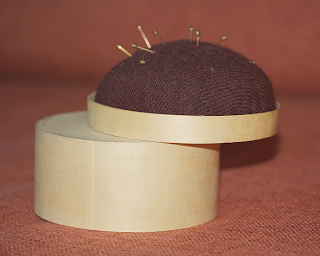Pins and even more so needles are an archaeological problem because they are so small. This means that unless there is a nest of pins or needles or unless there is a huge stroke of luck, these tiny metal rods will never be found. If they ever survived the corrosive surroundings in damp soil, that is - something that iron or steel might not take these surroundings as kindly as copper alloy. And then these rare items are so much overlooked - because duh, of course they had needles, that's an everyday item, isn't it? - that there is no collation of needle articles or archaeological needle knowledge yet.
There are two possible ways to find out what needles were in use. One way is to find surviving specimens, analyse them, and if possible make some replicas and try them out. That, of course, is quite difficult because of the scarcity of finds and well-published needles.
The other way is by deduction. It is against all logic that medieval people bought extremely costly materials like gold thread and fine silk to weave enormously fine fabrics and embroider them all over with beautiful, awe-inspiring motifs using a huge, bulky (needle) bodkin only, dragging this huge metal abnormity through their costly fine fabric! Fine fabrics require fine tools, and not only density, but fabric type makes a difference too in which tools are needed.
Both ways - deduction as well as the rare archaeological finds - will lead to the conclusion that fine needles were manufactured and used, and that medieval needles were at least partly also made of steel.
The needles offered here are made from non-stainless steel; stainless steel is a more modern invention. Non-stainless means that the needles might discolour with use due to skin oils. Any discolouring can be removed by polishing the needle with extremely fine sandpaper. Better, though, is the prevention by storing the needles dry, not using them with wet or dirty fingers, and best is storing them in a scrap of wool with lanolin content to conserve them.
They have relatively large eyes in a flattened head, designed to take the thread through the fabric without rubbing it and are thus perfect for embroidery with delicate silk or gold threads. This means they are not only wonderful for stitching cloth together, but very well suited for embroidery too.
The needles are completely hand-made by one of the few remaining traditional needle-makers - in Japan, because traditional needle-making has about died out in Germany.
There are two possible ways to find out what needles were in use. One way is to find surviving specimens, analyse them, and if possible make some replicas and try them out. That, of course, is quite difficult because of the scarcity of finds and well-published needles.
The other way is by deduction. It is against all logic that medieval people bought extremely costly materials like gold thread and fine silk to weave enormously fine fabrics and embroider them all over with beautiful, awe-inspiring motifs using a huge, bulky (needle) bodkin only, dragging this huge metal abnormity through their costly fine fabric! Fine fabrics require fine tools, and not only density, but fabric type makes a difference too in which tools are needed.
Both ways - deduction as well as the rare archaeological finds - will lead to the conclusion that fine needles were manufactured and used, and that medieval needles were at least partly also made of steel.
The needles offered here are made from non-stainless steel; stainless steel is a more modern invention. Non-stainless means that the needles might discolour with use due to skin oils. Any discolouring can be removed by polishing the needle with extremely fine sandpaper. Better, though, is the prevention by storing the needles dry, not using them with wet or dirty fingers, and best is storing them in a scrap of wool with lanolin content to conserve them.
They have relatively large eyes in a flattened head, designed to take the thread through the fabric without rubbing it and are thus perfect for embroidery with delicate silk or gold threads. This means they are not only wonderful for stitching cloth together, but very well suited for embroidery too.
The needles are completely hand-made by one of the few remaining traditional needle-makers - in Japan, because traditional needle-making has about died out in Germany.







